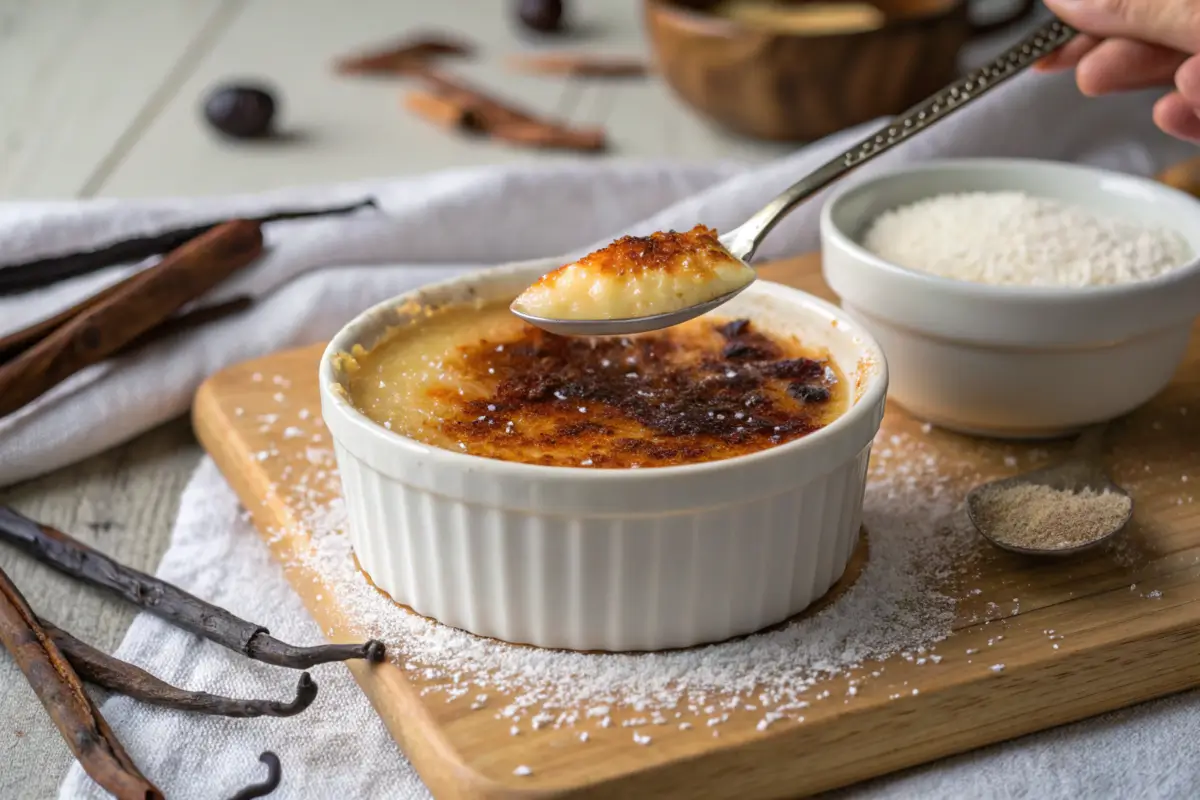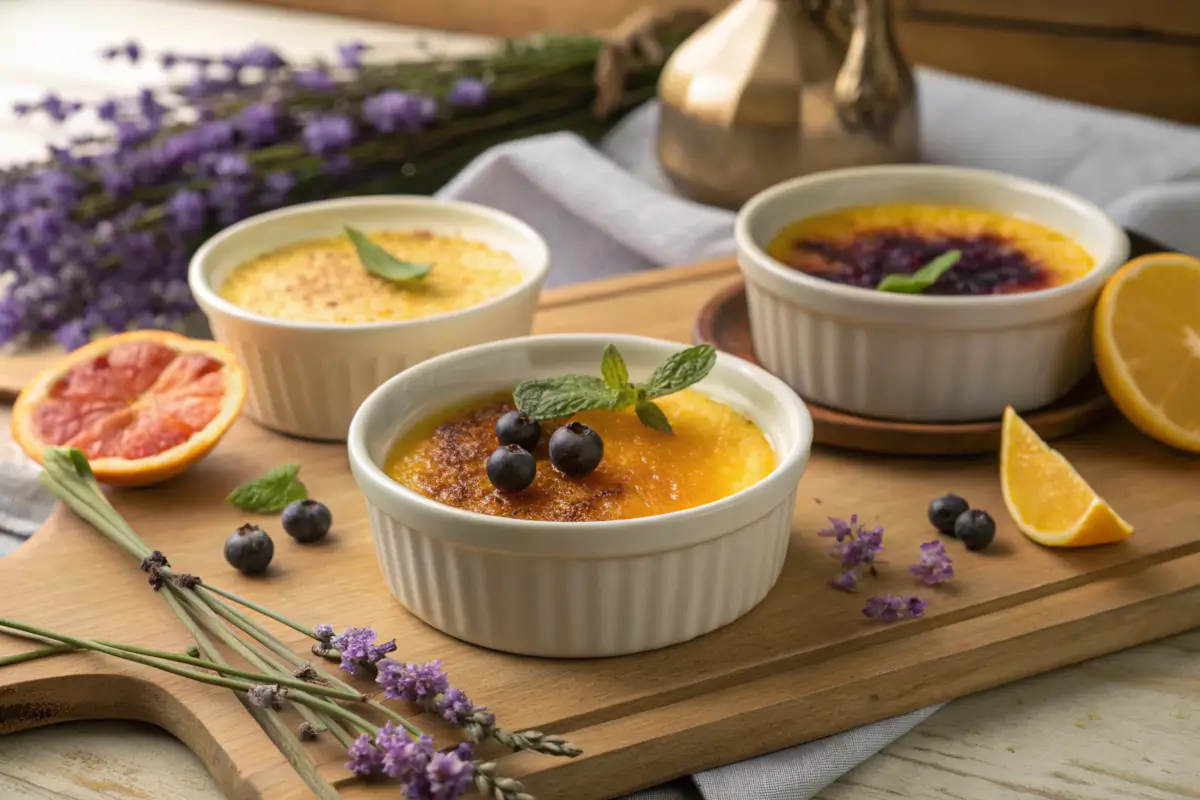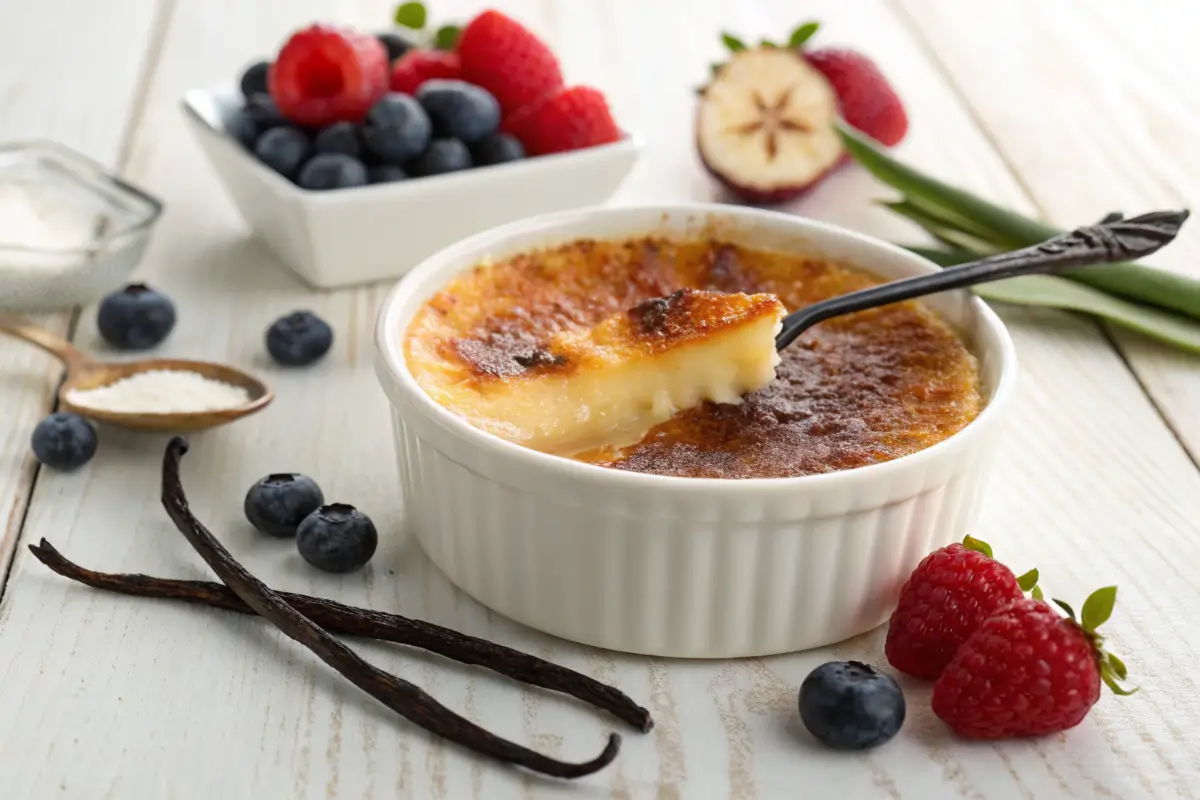Crème brûlée is a dessert that whispers sophistication and indulgence with every bite. But what does crème brûlée taste like? This timeless treat combines a rich, velvety custard base with a crackling caramelized sugar crust, creating a symphony of flavors and textures. Whether you’re a seasoned foodie or a curious first-timer, understanding what makes crème brûlée so special is a journey worth taking. This article dives into its flavor profile, texture, preparation secrets, and more, offering you a complete guide to this iconic dessert.
Introduction to Crème Brûlée
What Is Crème Brûlée?
Crème brûlée, which translates to “burnt cream” in French, is a culinary masterpiece with roots in European gastronomy. It’s crafted using a few simple ingredients—vanilla-infused cream, egg yolks, and sugar—yet the result is anything but ordinary. Its top layer, a golden-brown caramelized crust, is torched to perfection, creating a delightful contrast to the silky custard beneath.
Originating in France, crème brûlée has graced dining tables worldwide, becoming synonymous with elegance. From cozy cafes in Paris to high-end restaurants across the globe, this dessert remains a beloved staple.
Why Is Crème Brûlée So Popular?
Crème brûlée’s allure lies in its simplicity and balance. Its creamy base isn’t overly sweet, allowing the natural flavors of vanilla and cream to shine. The thin caramelized sugar crust adds a subtle smokiness and crunch that complements the smooth custard. This perfect harmony of textures and tastes is what keeps people coming back for more.
Additionally, crème brûlée is versatile. While the traditional version is undeniably popular, chefs often experiment by infusing it with flavors like chocolate, citrus, and lavender. This adaptability ensures it appeals to a broad range of palates, from classic dessert lovers to adventurous foodies.
Crème brûlée’s fame isn’t just about taste—its preparation feels like an art form. The satisfying crack of a spoon breaking through its caramelized layer is a sensory delight, making every serving a memorable experience. Whether enjoyed after a romantic dinner or as a luxurious treat, crème brûlée embodies culinary perfection.
Breaking Down the Flavor Profile
The Sweet and Creamy Base

The defining element of crème brûlée is its luscious, vanilla-infused custard. This base has a subtle sweetness that perfectly balances the richness of cream and egg yolks. Unlike overly sugary desserts, crème brûlée allows the natural flavors to shine through, creating a sophisticated and refined taste. The creamy custard is smooth and light on the palate, making it a favorite for those who appreciate a less cloying dessert.
Variations on this classic recipe can elevate the flavor profile. For instance, chocolate lovers often enjoy crème brûlée infused with rich cocoa, while coffee aficionados adore the depth added by espresso. Seasonal twists, like citrus zest or exotic spices, offer creative spins on the traditional dessert, ensuring that there’s a version for every taste preference.
The Contrasting Caramelized Topping
The caramelized sugar crust is where crème brûlée earns its iconic status. This golden-brown layer of burnt sugar provides an addictive, crackly texture that contrasts beautifully with the smooth custard below. Its smoky sweetness complements the custard’s creaminess, adding complexity to each bite.
Achieving the perfect caramelized top requires precision. The sugar is either torched or broiled until it melts and hardens, creating a brittle, glossy crust. This technique not only enhances the flavor but also adds visual appeal. Breaking through the crisp topping with a spoon is a delightful experience, setting the stage for the indulgence to come.
Texture and Mouthfeel of Crème Brûlée
The Creamy Custard Layer
One of the most captivating aspects of crème brûlée is its texture. The custard is silky smooth, achieved by carefully whisking and baking the mixture. Its luxurious mouthfeel comes from the balance between heavy cream and egg yolks, which create a custard that’s rich yet not overly dense. The lightness of the custard is key to its appeal, as it melts effortlessly on the tongue.
The baking process is critical to ensuring the custard’s signature texture. By using a water bath, the heat is evenly distributed, preventing curdling and ensuring a uniformly creamy consistency. Any deviation in technique can result in a grainy or lumpy texture, which detracts from the dessert’s elegance.
The Crunchy Top Layer
The contrasting textures are what truly set crème brûlée apart. The caramelized crust provides a satisfying crunch that complements the custard’s softness. The crack of the crust under the spoon is not just auditory—it’s part of the entire sensory experience. This layer, often described as a delicate sheet of glass, encapsulates the custard, locking in its freshness and enhancing the overall taste.
Mastering the caramelization process is an art form. Using a culinary torch allows for precision, giving the sugar just enough heat to caramelize without burning. The result is a perfectly even crust that’s both beautiful and delicious.
Comparing Crème Brûlée to Other Desserts
Crème Brûlée vs. Flan
When it comes to creamy, custard-based desserts, crème brûlée and flan often come to mind. While they share some similarities, their differences are stark. Crème brûlée’s flavor centers around its vanilla custard and caramelized sugar topping, whereas flan features a caramel sauce that infuses the entire dessert. Flan has a softer, jiggly texture due to its reliance on whole eggs, while crème brûlée boasts a more decadent, velvety consistency thanks to its rich cream and egg yolks.
Another defining characteristic is the preparation method. Flan is inverted onto a plate, showcasing its golden caramel sauce, while crème brûlée is served in its ramekin with a glossy, crackly crust. While both are delightful, crème brûlée’s crunchy topping gives it a unique appeal that sets it apart.
Crème Brûlée vs. Panna Cotta
Panna cotta, another elegant dessert, is often compared to crème brûlée. Though both are creamy, they differ significantly in texture and flavor. Panna cotta is made with cream, sugar, and gelatin, resulting in a wobbly, pudding-like dessert. Its flavor is lighter and less complex than crème brûlée, which combines the richness of custard with the smokiness of its caramelized topping.
Where panna cotta is typically flavored with fruit purees or coffee, crème brûlée’s emphasis on vanilla and burnt sugar creates a more indulgent experience. Both desserts have their charm, but crème brûlée’s texture contrasts and visual presentation make it the go-to choice for those seeking something truly luxurious.
For more ideas on creating elegant desserts, check out the Crab Brûlée Recipe on Dish It Recipes. It’s a savory twist on the classic brûlée that might surprise you.
How to Enhance the Taste of Crème Brûlée
Adding Unique Flavors

One of the best things about crème brûlée is how adaptable it is. While the traditional recipe is beloved, adding unique flavors can elevate the experience. Infusions like citrus zest, lavender, or spices like cinnamon can bring new dimensions to the dessert. For instance, a hint of orange zest in the custard pairs beautifully with the caramelized sugar topping, adding a fresh, tangy kick.
Another option is experimenting with flavored extracts. Almond, hazelnut, or even coconut extracts can transform the classic custard into something unforgettable. By tailoring the flavors, crème brûlée can cater to a variety of palates while maintaining its luxurious essence.
Pairing with Complementary Foods and Beverages
Crème brûlée shines on its own, but thoughtful pairings can enhance its taste even more. Fresh berries, like raspberries or blackberries, provide a tart contrast to the dessert’s creamy richness. Pairing crème brûlée with a glass of dessert wine, such as Sauternes or Moscato, elevates the dining experience, balancing the sweetness and adding complexity to the meal.
For coffee lovers, serving crème brûlée with a freshly brewed espresso offers a delightful balance between the dessert’s creamy sweetness and the coffee’s bitter notes. Alternatively, a light, crisp white wine complements the richness without overpowering the flavors.
Tips for Making the Best Crème Brûlée at Home
Choosing the Right Ingredients
When it comes to making the perfect crème brûlée, the ingredients you use can make or break the dessert. What does crème brûlée taste like? Its rich, velvety custard relies on high-quality cream as the foundation of its indulgent texture. Opt for fresh, free-range eggs to achieve that silky smooth custard. And, of course, don’t skimp on the vanilla. Whether you choose vanilla beans, paste, or extract, it should be fragrant and pure to impart the dessert’s signature flavor.
Using the right sugar is equally important. Superfine sugar caramelizes more evenly, giving you the ideal crackly crust that crème brûlée is known for. Finally, avoid shortcuts with pre-made mixes—homemade crème brûlée always tastes fresher and more luxurious.
Mastering the Caramelization Technique
Achieving that perfect caramelized topping is an art form. Once the custard has chilled, evenly sprinkle a thin layer of sugar across the surface. Then, using a kitchen torch, apply heat until the sugar melts and turns golden-brown. Move the flame in a circular motion to avoid burning one spot while ensuring an even finish.
If you don’t have a torch, you can use your oven’s broiler. Place the ramekins on a baking sheet and broil for 1-2 minutes, keeping a close eye to prevent over-browning. This final step is crucial because the crisp sugar layer is what transforms crème brûlée from a simple custard into an unforgettable dessert.
FAQs About Crème Brûlée
What Does Crème Brûlée Taste Like to a First-Time Eater?
For someone tasting crème brûlée for the first time, it’s often described as a delightful blend of silky vanilla custard with a hint of smokiness from the caramelized sugar topping. The contrast between the creamy base and the crisp crust creates a balance of textures and flavors that’s both luxurious and satisfying.
Is Crème Brûlée Too Sweet for Some People?
Surprisingly, crème brûlée isn’t overly sweet. The custard has a mild sweetness, and the caramelized topping adds just the right amount of smoky, sugary notes. It’s a dessert that appeals to a wide range of tastes, even for those who prefer less sugary treats.
What Are Some Unique Variations of Crème Brûlée?
Crème brûlée’s versatility makes it a canvas for creativity. From adding flavors like lavender, matcha, or espresso to experimenting with toppings like fresh fruit or chocolate shavings, there are countless ways to personalize this dessert. Savory versions, like crab brûlée, are also gaining popularity for adventurous palates.
Why Is My Crème Brûlée Texture Grainy?
A grainy texture usually means the custard was overcooked or the ingredients weren’t properly combined. To prevent this, cook the custard in a water bath to maintain a gentle, even heat. Also, whisk the ingredients thoroughly but avoid creating too much foam, which can affect the final texture.
Pairing Crème Brûlée with Other Desserts
Crème Brûlée and Light Desserts
Crème brûlée’s rich, creamy texture pairs beautifully with light and refreshing desserts. For example, serving it alongside a fresh fruit salad balances the indulgent custard with the natural sweetness of berries, melons, or citrus slices. Sorbets, particularly lemon or raspberry, are also excellent companions, as their tanginess cleanses the palate and contrasts the vanilla-infused creaminess of crème brûlée.
Another popular pairing is a delicate meringue or macaron. These airy, sweet treats complement the caramelized sugar crust without overwhelming the overall flavor. Whether you’re hosting a dinner party or indulging solo, these combinations add variety to your dessert table.
Crème Brûlée and Decadent Treats
For those who prefer indulgence, pairing crème brûlée with other rich desserts can create a truly decadent experience. A small slice of dark chocolate torte, for instance, adds a bittersweet counterpoint to the dessert’s mild sweetness. Alternatively, serving crème brûlée with a warm, buttery almond pastry creates a textural contrast that enhances the overall enjoyment.
Crème Brûlée Around the World
Regional Variations of Crème Brûlée
Though crème brûlée is famously French, it has inspired desserts worldwide. But what does crème brûlée taste like in other cultures? In Spain, crema catalana offers a similar experience, featuring a silky custard base flavored with cinnamon and citrus, topped with caramelized sugar. Similarly, Italy’s zabaione draws from the custard tradition, though it’s often served as a sauce or drink rather than a standalone dessert.
Asian adaptations also highlight unique ingredients, such as matcha crème brûlée in Japan or pandan-flavored versions in Southeast Asia. These regional twists retain the essence of crème brûlée while introducing local flavors, proving its universal appeal.
Crème Brûlée in Modern Cuisine
In contemporary cuisine, crème brûlée continues to evolve. Chefs now experiment with savory variations, incorporating ingredients like goat cheese or truffle oil for a surprising twist. These versions transform the dessert into a sophisticated appetizer or entrée component.
Even within the sweet realm, modern chefs push boundaries by combining crème brûlée with other desserts. Think crème brûlée cheesecakes or doughnuts filled with custard and topped with caramelized sugar. These hybrids combine the best of multiple worlds, ensuring crème brûlée’s enduring place on menus worldwide.

